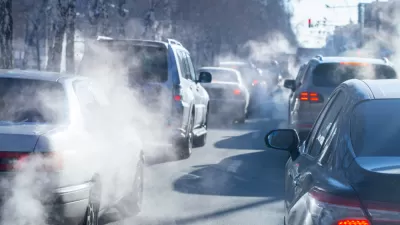As the popularity of delivery services grows, regulation and tech can address pollution challenges and limit congestion.

An article by Ysabelle Kempe in Smart Cities Dive highlights the efforts of eight cities and one county to reduce emissions from delivery services as part of a zero-emissions delivery challenge launched by Climate Mayors, C40, and the Los Angeles Cleantech Incubator with funding from Wells Fargo.
According to the National League of Cities, demand for delivery services could drive up emissions by 32 percent, prompting cities to assess ways to limit pollution, which often disproportionately affects low-income communities near distribution centers.
In Santa Monica, California, only clean delivery vehicles can enter a ‘zero-emissions delivery zone’ in the city’s center. New York City wants to move more freight to its rivers to reduce traffic on local roads, while “Washington, D.C., plans to leverage the support of the cohort to create a delivery microhub that supports more sustainable last-mile delivery modes, such as e-cargo bikes.” Other strategies include deliveries at off-peak hours and stricter curb management regulations.
As Kempe explains, “Through the zero-emissions delivery challenge, cities will identify innovative startup and corporate solutions to try. On top of getting access to funding for select startup solutions, participating cities will receive technical support, data analysis, peer-to-peer learnings and meetings with existing private sector delivery companies.”
FULL STORY: Delivery has a pollution problem. These cities are working to address it.

Alabama: Trump Terminates Settlements for Black Communities Harmed By Raw Sewage
Trump deemed the landmark civil rights agreement “illegal DEI and environmental justice policy.”

Planetizen Federal Action Tracker
A weekly monitor of how Trump’s orders and actions are impacting planners and planning in America.

The 120 Year Old Tiny Home Villages That Sheltered San Francisco’s Earthquake Refugees
More than a century ago, San Francisco mobilized to house thousands of residents displaced by the 1906 earthquake. Could their strategy offer a model for the present?

In Both Crashes and Crime, Public Transportation is Far Safer than Driving
Contrary to popular assumptions, public transportation has far lower crash and crime rates than automobile travel. For safer communities, improve and encourage transit travel.

Report: Zoning Reforms Should Complement Nashville’s Ambitious Transit Plan
Without reform, restrictive zoning codes will limit the impact of the city’s planned transit expansion and could exclude some of the residents who depend on transit the most.

Judge Orders Release of Frozen IRA, IIJA Funding
The decision is a victory for environmental groups who charged that freezing funds for critical infrastructure and disaster response programs caused “real and irreparable harm” to communities.
Urban Design for Planners 1: Software Tools
This six-course series explores essential urban design concepts using open source software and equips planners with the tools they need to participate fully in the urban design process.
Planning for Universal Design
Learn the tools for implementing Universal Design in planning regulations.
Clanton & Associates, Inc.
Jessamine County Fiscal Court
Institute for Housing and Urban Development Studies (IHS)
City of Grandview
Harvard GSD Executive Education
Toledo-Lucas County Plan Commissions
Salt Lake City
NYU Wagner Graduate School of Public Service





























